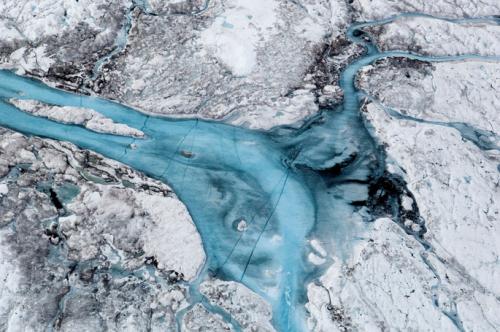Media Advisory: NSIDC launches “Greenland Ice Sheet Tuesday,” reviews extreme melt season of 2012
This is a media advisory from the National Snow and Ice Data Center (NSIDC), which is part of the Cooperative Institute for Research in Environmental Sciences at the University of Colorado Boulder.
The National Snow and Ice Data Center Tursday that offers the latest satellite data and periodic scientific analysis on surface melting of the Greenland Ice Sheet, a significant climate indicator watched by climate scientists worldwide. The site presents images of the widespread melt on Greenland during 2012 and scientific commentary on the year’s record-breaking melt extent.

Aerial view of meltwater lakes and streams on Greenland Ice Sheet east of Kangerlussuaq.
In recent years, the surface of the Greenland Ice Sheet has experienced strong melting, but the 2012 melt season far exceeded all previous years of satellite monitoring, and led to significant amounts of ice loss for the year.
The Greenland Ice Sheet contains a massive amount of fresh water, which if added to the ocean could raise sea levels enough to flood many coastal areas where people live around the world. The ice sheet normally gains snow during winter and melts some during the summer, but in recent decades its mass has been dwindling due to strong melting.
“Greenland Ice Sheet features analysis by the NSIDC science team and satellite images updated daily, with a one-day lag. A daily melt image shows where the surface of the Greenland Ice Sheet experienced melt on that day.
The inspired by the extreme melt event on the Greenland Ice Sheet in July 2012. While evidence of past heat waves similar to this can be found in ice core records, it had never been seen in the satellite record.
NSIDC scientists at the University of Colorado Boulder developed Greenland Ice Sheet Today with partial support from NASA, and with data from Thomas Mote of the University of Georgia, and additional collaboration from Marco Tedesco of the City University of New York.
Source: National Snow & Ice Data Center
- 457 reads
Human Rights
Fostering a More Humane World: The 28th Eurasian Economic Summi

Conscience, Hope, and Action: Keys to Global Peace and Sustainability

Ringing FOWPAL’s Peace Bell for the World:Nobel Peace Prize Laureates’ Visions and Actions

Protecting the World’s Cultural Diversity for a Sustainable Future

Puppet Show I International Friendship Day 2020

